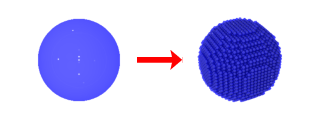|
|
 |
CoupledDipole.jl
Coupled-dipole simulations for electromagnetic scattering of light by sub-wavelength particles in arbitrary 3-dimensional configurations.

Extended DDA (e-DDA)
Extended discrete dipole approximation, DDA application to bianisotropic media.
Coupled Dipole Approximation (CDA)
Coupled Dipole Approximation with Linux parallel compatibility.
weak_FEM_BEM_coupling
The electromagnetic transmission-scattering problem. The method is an efficient weak coupling formulation between the boundary element method and the high-order finite element method. The approach is based on the use of a non-overlapping domain decomposition method involving quasi-optimal transmission operators.
CDPDS Coupled dipole method-based photonic dispersion solver
A photonic band dispersion solver based on the coupled dipole method called CDPDS, which aims to provide an analytical computation of bulk and boundary dispersions and topological phases of a one-dimensional and two-dimensional photonic crystal consisting of an array of particles.
IF-DDA Idiot Friendly-Discrete dipole approximation
IF-DDA is a numerical tool for solving the electromagnetic scattering problem in three dimensions. IF-DDA is based on the DDA (discrete dipole approximation) which is a volume-integral equation method.

Graph-theory-dda
The code can handle N scatterer systems in arbitrary settings, but shines for cyclic polygon settings
Diffused-Particle-Method
The Foldy-Lax equation is generalized for a medium which consists of particles with both electric and magnetic responses. The result is used to compute fields scattered from ensembles of particles.
Rank-one Decomposition accelerated DDA method (RD-DDA)
Link (2 May 2023)
VoxScatter
Matlab repository for computing electromagnetic scattering by dielectric particles.

|
|
 |
|